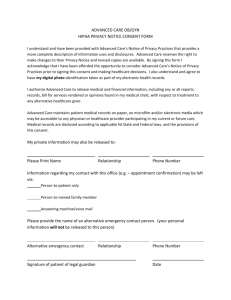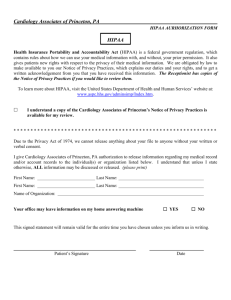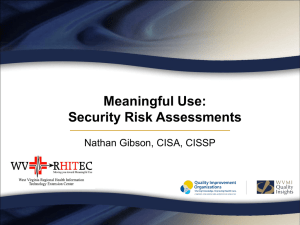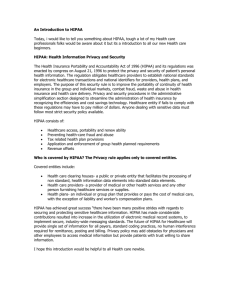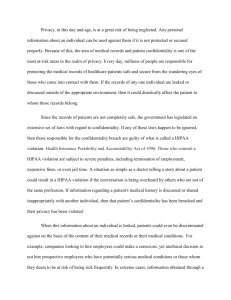NDPPS Template Guide - Global Health Care, LLC
advertisement
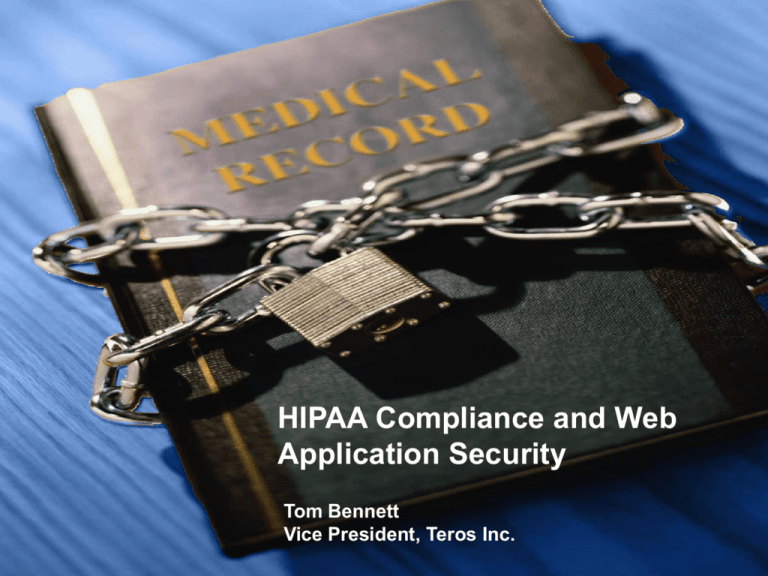
HIPAA Compliance and Web Application Security Tom Bennett Vice President, Teros Inc. Agenda HIPAA Overview – Current Status Basics – Electronic Data Exchange – Web Applications Typical Healthcare Web Applications Vulnerabilities Overview Identity Theft and Database Breach – Compliance and Liability Implications What you can do about it! Web Applications are a Hacker’s the Entry Point ¿ Online Health Services are Vulnerable – 70% of attacks are at web applications – SSN, Private Data and Account #s most vulnerable to theft and compromise. Existing security does not stop web applications attacks – Firewalls, IDS and SSL protect networks, not individual applications Security breaches cost millions – Lost revenue, Brand Erosion, Customer Retention, PR Web Application Security is Required! – HIPAA means you are responsible – Database Breach Act—Liability! What are the consequences? Defacement is the least of your worries! – Identity Theft – Lost revenue – System repair and downtime Identity Theft is HUGE – Short term PR, lost customers longer term – Now you are liable! You may be an unwilling facilitator in someone else’s disaster – Cross-site attacks – Application as entry point to corporate networks! Healthcare Insurance Portability and Accountability Act Comprehensive security programs Administrative Simplification Who is Affected? – Covered Entities o Health Plan o Health Care Clearinghouse o Health Care Provider – Business Associates Penalties for Non-compliance – – Civil Criminal What are people doing? Winter 2002 Survey - www.hipaadvisory.com HIPAA - Title II HIPAA Title I Health insurance access, portability and renewal Title II Title III Fraud and Abuse Medical Liability Reform Medical Savings Accounts Tax deduction provisions Administrative Simplification Electronic Transaction Standards (EDI) Security Standards Privacy Standards Title IV Group health plan provisions For 9 key payor transactions Includes clinical code sets Includes key identifiers For protecting electronic health information To spell out permissible uses of patient identifiable healthcare information Title V Revenue offset provisions Administrative Simplification Regulatory Requirements Electronic Data Interchange Transaction Sets Standardized Codes Sets Standardized Identifiers (EDI/TCI) – Trading Partner – Transaction – – – – Standard Setting Organization (SSO) Transaction Sets Code Sets Unique Identifiers Trading Partner In Electronic Data Interchange (EDI) this generally applies to two parties engaged in the exchange of business data through electronic means. Sender Message Receiver – Health Care claims or equivalent encounter information. – Health Care payment and remittance advice. – Coordination of benefits. – Health Care claim status. – Enrollment and disenrollment in a health plan. – Eligibility for a health plan. – Health plan premium payments. – Referral certification and authorization. – First report of injury. – Health claims attachments. – Other transactions that the Secretary may prescribe by regulation. X.12 Transaction Sets Health Care Plans Health Care Providers 834 Enrollment 270 Eligibility Request Eligibility Verification 271 Eligibility Response Member Services 278 Referral Request Precertification and Referrals 278 Referral Response Eligibility Verification 837 Claim Service Billing / Claim Submission 275 Additional Information 277 Claim Status Response Claim Receipt and Routing 276 Claim Status Request Claim Reconciliation 277 Claim Status Response Employers Claim Status Adjudication 820 Premium Payment Enrollment Privacy and Security Privacy Ruling - Who Can Disclose Data – The need for information security to ensure privacy is delineated: .It is the responsibility of organizations that are entrusted with health information to protect it against deliberate or inadvertent misuse or disclosure.. Security Ruling - Protecting Data – Mandates safeguards for physical storage and maintenance, transmission and access to individual information. Protected Health Information (PHI) "PHI" means any information allowing direct or indirect identification of an individual through one or more specific characteristics of the individuals' physical, physiological, or mental condition. Such information includes, but is not limited to: Name Address E-Mail Address Social Security Number Password (if used to access the site) Bank Account Information Credit Card Information Any combination of Data that could be used to identify a consumer, such as the consumer's birth date, zip code and gender. Security & Privacy Privacy - an individual’s rights to control access and disclosure of their protected or individually identifiable healthcare information (IIHI) – – – – Establish authorization requirements Establish administration requirements Establish individual rights Establish regulations for use or disclosure of Protected Health Information (“PHI”) Security - an organization’s responsibility to control the means by which such information remains confidential – – – – Physical Safeguards Administrative Procedures Technical Security Services Technical Security Mechanisms Web Application Security Web Applications need protection Incidents Doubling yearly Banks Targeted Regulatory Compliance Now legal liability Vulnerabilities Doubling yearly IIS prime target 80% More Business Moving to the web and web services Experts say Application Security A “must-have” Web Vulnerability and Incident Explosion California’s Database Breach “Enterprises must ensure that Notification Act (SB 1386) their firewalls perform deep “The number of dramatically escalates the “If incidents continue atapply packet inspection and vulnerabilities has “The primary impediment needcurrent for companies to their pace, 2003’s security policies based on skyrocketed, 85% more to web services secure their key customer total will be an 86 percent application content to than the same period deployment lack of data suchover asiscredit card increase the 2002”. effectively block last year..” security...” numbers and social security CERT cyberattacks.” eWeek February 2003 (Everyone) numbers. Gartner August 2003 Benjamin Wright HIPAA Information Flow Clinical Laboratory Physicians/Groups • Medical Staff • Primary Care The Patient Hospitals/Providers • Acute Care • Rehabilitation • Long Term Care ? Life Insurance Company Consulting Physician Accrediting Organization Managed Care Organization Your Employer Your School/College Your Dentist Your Health Club Your Day Care Provider Medical Information Bureau State Vital Stats Retail Pharmacy Pharmacy Benefits Mgr Lawyers Medical Research Typical Healthcare Web Applications Patient – Appointment Scheduling Confirmation – Benefits Reviews – Prescription Fulfillment Physicians Groups, Hospitals, Pharmacies etc. – Patient Records Patient/Care Summaries Prescriptions Assignment Appointment Scheduling Health/Life Insurance Companies – Benefits Plans Summaries of Benefits Designation of Beneficiaries Managed Care Organizations – Patient Records Patient/Care Summaries Summaries of Benefits Lawyers, Accrediting Organizations, Medical Information/Research – Healthcare Provider Records – Benefits Plans You need to protect your web infrastructure… Corporate LAN Web Infrastructure Public Web Server Authorized User HTTP HTTPS Secure Application Gateway Web Application Database Intranet Web Server Hacker Web Security Gateways do what firewalls, IDS, and VPN’s do for the network 1 Complete Web Application Security Protects 16 of 16 application vulnerability classes Protects 10 of 10 OWASP Top Ten ALL IIS web vulnerabilities: Automatically Protected ALL web worms - Code Red, Nimda, …: Automatically Protected ALL published exploits in Hotmail: Automatically Protected Vulnerability Score Card 1 Buffer Overflow Exploits 2 CGI-BIN Param Manipulation 3 Form/Hidden Field Manipulation 4 Forceful Browsing 5 Cookies/Session Poisoning 6 Broken ACLs / Weak Passwords 7 Cross-site Scripting (XSS) 8 Command Injection 9 SQL Injection 10 Error Triggering 11 Insecure use of Crypto 12 Server Misconfiguration 13 Backdoors & Debug Options 14 Web-site Defacement 15 Well-known Platform Vulnerabilities 16 Unpublished Attacks Sensitive Information Leaks Typical Vulnerabilities Web application PHI collection Blue Cross/Shield of California Web application SSL Session Literal paths in web app coding Cookies Cookies can link identity and activity across distinct organizations .website.net TRUE / FALSE 1920499140 id 800000007f2c6c9 Sender of cookie Unique ID for cookie Web Servers Web servers see more than the user knows… Users IP address Timestamp File requested 209.167.234.37 - - [26/Jan/2001:00:22:54 -0500] "GET /pages/index.html HTTP/1.0” 200 557 "http://www.website.com/" "Mozilla/4.0 (compatible; MSIE 5.5; Windows 95)" Previous location Type of application Recommendations Full disclosure about … Clients’ use of self cookies Use of third party cookies on clients web site Use of third party 1x1 clear pixel tags on clients web site Third party/partners’ involvement in data collection and analysis Prominently display link to privacy statement on all web pages: Place “Privacy” link at top of page (versus bottom, where most companies place it) and make it very prominent (I.e., larger font, bolded, etc.) Web Security Gateways Bulletproof Security Integrated protection that inspects all web traffic in real time Ability to identify and block attacks, regardless Blocks both known and “zero-day” attacks Ability to protect YOUR application’s unique code Bi-directional security: – Stop incoming attacks – Block outgoing unauthorized data Enterprise Manageability Scale to handle high-volume enterprise application traffic Global AND Granular adminstration and delegation for complex apps Support for SSL Hot Failover and HA Minimal integration and configuration Web Security Gateways • – – – – – – Real-Time Protection from Malicious Attacks within Web Data Path Assures the performance and uptime of web apps Eliminates all classes of application attacks APMs Protects private data (credit card numbers, social security numbers, account numbers, etc.) Eliminates web site defacement Enables Security and Privacy Regulation Compliance Simple to deploy security appliance Case Study-State Medicare Org The Problem – Online Medicare Claims Processing Application – Private health data protected by HIPAA – Realized only app code was protecting this data – Primary concern was enforcing specific policy and the ability to audit – Required SSL & Performance The Solution – APS HA with SSL – SAFEIdentity Module – Application logic and data are now secured – Security is auditable and uniform – Complete compliance with HIPAA requirements for private data protection HIPAA - References http://aspe.os.dhhs.gov/admnsimp Department of Health and Human Services http://www.hcfa.gov Health Care Financing Administration http://ncvhs.hhs.gov National Committee on Vital and Health Statistics http://www.wedi.org Workgroup for Electronic Data Interchange web site. Site includes information on EDI in the health care industry, lists of conferences and other resources. http://www.afehct.org Association for Electronic Healthcare Transactions http://www.ahima.org American Health Information Management Association http://www.ehnac.org The Electronic Healthcare Network Accreditation Commission http://www.hipaadvisory.com General HIPAA Information Site http://www.hipaacomply.com General HIPAA Information Site
